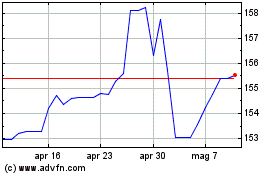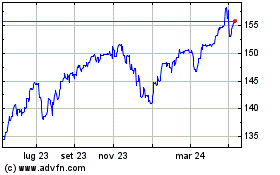U.S. Dollar Advances On Fed Rate Hike Prospectus
10 Luglio 2017 - 8:51AM
RTTF2
The U.S. dollar firmed against its major rivals in the European
session on Monday, as Friday's solid jobs data suggested that the
economy is on a solid footing to enable the Fed to continue with
its tightening plans for the rest of the year.
U.S. non-farm payroll employment jumped by 222,000 jobs in June
following an upwardly revised increase of 152,000 jobs in May.
Despite the stronger than expected job growth, the unemployment
rate inched up to 4.4 percent from 4.3 percent in May.
Better-than-expected jobs data supported continued policy
tightening by the Federal Reserve with another rate hike this
year.
The Fed Chair Janet Yellen set to deliver her semiannual
testimony on monetary policy to the House Financial Services
Committee on Wednesday, and before the Senate Banking Committee on
Thursday.
Yellen's speech will be closely watched for assessments on the
U.S. economy and the outlook of the Fed's monetary policy in the
course of the year.
Investors also focus on weekly jobless claims and producer price
index on Thursday, as well as the consumer price index, retail
sales, industrial production and consumer sentiment - all due
Friday for more clues about the health of the economy.
The greenback traded mixed against its major rivals in the Asian
session. While the greenback held steady against the franc and the
euro, it rose against the yen. Against the pound, it declined.
The greenback climbed to a 5-day high of 0.9662 against the
franc, from a low of 0.9630 hit at 3:45 am ET. The next likely
resistance for the greenback-franc pair is seen around the 0.98
region.
The greenback hit 114.30 against the yen, its strongest since
May 11. If the greenback-yen pair extends rise, 118.5 is possibly
seen as its next resistance level.
Data from the Ministry of Finance showed that Japan posted a
current account surplus of 1,653.9 billion yen in May.
That missed forecasts for 1,792.8 billion yen following the
1,951.9 billion yen surplus in April.
The greenback reversed from an early low of 1.1418 against the
euro, rising to 1.1382. On the upside, 1.12 is possibly seen as the
next resistance for the greenback.
Survey results from think tank Sentix showed that Eurozone
investor confidence moderated in July.
The investor confidence index fell marginally to 28.3 in July
from a near decade high. The score was forecast to fall to 28.2
from 28.4 in June.
The greenback advanced to near a 2-week high of 1.2858 against
the pound, after having declined to 1.2908 at 2:00 am ET.
Continuation of the greenback's uptrend may see it challenging
resistance around the 1.27 mark.
The greenback bounced off to 0.7265 against the kiwi, 0.7587
against the aussie and 1.2928 against the loonie, from its early
lows of 0.7283, 0.7615 and 1.2872, respectively. The greenback is
likely to target resistance around 0.71 against the kiwi, 0.74
against the aussie and 1.30 against the loonie.
Looking ahead, U.S. labor market conditions index for June and
U.S. consumer credit for May are slated for release in the New York
session.
Grafico Cross US Dollar vs Yen (FX:USDJPY)
Da Mar 2024 a Apr 2024

Grafico Cross US Dollar vs Yen (FX:USDJPY)
Da Apr 2023 a Apr 2024
